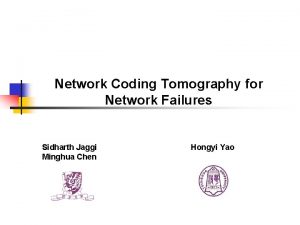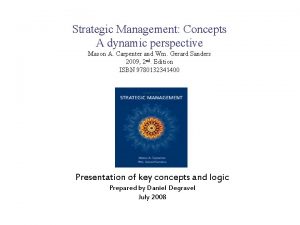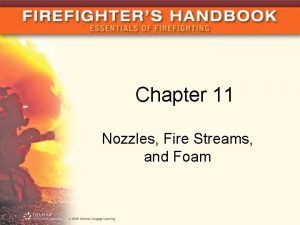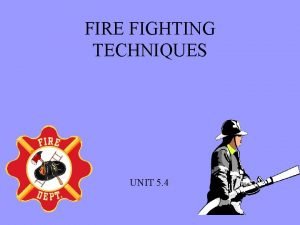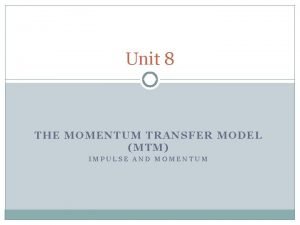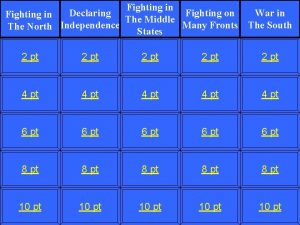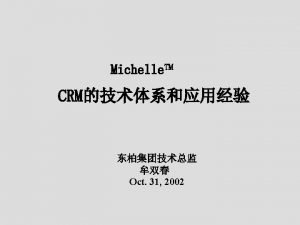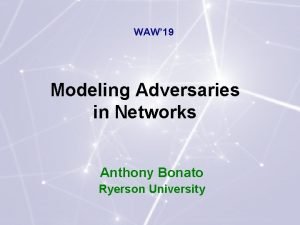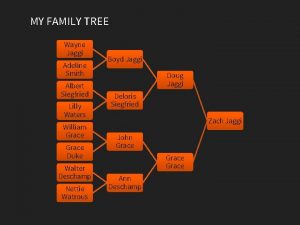FIGHTING ADVERSARIES IN NETWORKS Sidharth Jaggi MIT Michelle



![Gap Without Coding s [JSCEEJT 05]. . . Coding capacity = h Routing capacity≤ Gap Without Coding s [JSCEEJT 05]. . . Coding capacity = h Routing capacity≤](https://slidetodoc.com/presentation_image_h2/65ee70e3b544e12c91a28b0914b23a03/image-4.jpg)

![Background Upper bound for multicast capacity C, C ≤ min{Ci} t 1 [ACLY 00] Background Upper bound for multicast capacity C, C ≤ min{Ci} t 1 [ACLY 00]](https://slidetodoc.com/presentation_image_h2/65ee70e3b544e12c91a28b0914b23a03/image-6.jpg)
![Background F(2 m)-linear network b 1 b 2 bm [KM 01] Source: - Group Background F(2 m)-linear network b 1 b 2 bm [KM 01] Source: - Group](https://slidetodoc.com/presentation_image_h2/65ee70e3b544e12c91a28b0914b23a03/image-7.jpg)
![Background t 1 [ACLY 00] - achievable! C 1 C 2 t 2 s Background t 1 [ACLY 00] - achievable! C 1 C 2 t 2 s](https://slidetodoc.com/presentation_image_h2/65ee70e3b544e12c91a28b0914b23a03/image-8.jpg)




![Random Robust Codes Choose random [ß] at each node Percolate overall transfer function down Random Robust Codes Choose random [ß] at each node Percolate overall transfer function down](https://slidetodoc.com/presentation_image_h2/65ee70e3b544e12c91a28b0914b23a03/image-13.jpg)









![Unicast [JLHE 05] 0. 5 C (Capacity) 1 0 p. I=p. O 0. 5 Unicast [JLHE 05] 0. 5 C (Capacity) 1 0 p. I=p. O 0. 5](https://slidetodoc.com/presentation_image_h2/65ee70e3b544e12c91a28b0914b23a03/image-23.jpg)
![Unicast [Folklore] C (Capacity) 1 0 p. O 0. 5 1 (“Noise parameter”) (“Knowledge Unicast [Folklore] C (Capacity) 1 0 p. O 0. 5 1 (“Noise parameter”) (“Knowledge](https://slidetodoc.com/presentation_image_h2/65ee70e3b544e12c91a28b0914b23a03/image-24.jpg)



![Distributed Design [HKMKE 03] Choose random [ß] at each node Percolate overall transfer function Distributed Design [HKMKE 03] Choose random [ß] at each node Percolate overall transfer function](https://slidetodoc.com/presentation_image_h2/65ee70e3b544e12c91a28b0914b23a03/image-28.jpg)
![Distributed Design [HKMKE 03] Rate h=C xb(i) Block t 1 y 1 xs(j) hxh Distributed Design [HKMKE 03] Rate h=C xb(i) Block t 1 y 1 xs(j) hxh](https://slidetodoc.com/presentation_image_h2/65ee70e3b544e12c91a28b0914b23a03/image-29.jpg)





![Secret Uncorrupted ε-rate Channels Secret, correct hashes of xs(j) [r, (∑jxs(j)rj)] Zorba doesn’t know Secret Uncorrupted ε-rate Channels Secret, correct hashes of xs(j) [r, (∑jxs(j)rj)] Zorba doesn’t know](https://slidetodoc.com/presentation_image_h2/65ee70e3b544e12c91a28b0914b23a03/image-35.jpg)
![Achievability - 2 “Distributed Network Error-correcting Code” (Knowledge parameter p. I>0. 5) [CY 06] Achievability - 2 “Distributed Network Error-correcting Code” (Knowledge parameter p. I>0. 5) [CY 06]](https://slidetodoc.com/presentation_image_h2/65ee70e3b544e12c91a28b0914b23a03/image-36.jpg)








- Slides: 44

FIGHTING ADVERSARIES IN NETWORKS Sidharth Jaggi (MIT) Michelle Effros Michael Langberg Tracey Ho Philip Chou Kamal Jain Muriel Médard Dina Katabi Peter Sanders Ludo Tolhuizen Sebastian Egner

Network Coding. . . what is it? “The core notion of network coding is to allow and encourage mixing of data at intermediate network nodes. “ (Network Coding Homepage)

Justifications - I s Throughput b 1 b 2 ? b 1+b b 1 2 b 1 b 1+b b +b 2 1 2 t 1 t 2 (b 1 b, b 1 2) (b 1, b 2) [ACLY 00]
![Gap Without Coding s JSCEEJT 05 Coding capacity h Routing capacity Gap Without Coding s [JSCEEJT 05]. . . Coding capacity = h Routing capacity≤](https://slidetodoc.com/presentation_image_h2/65ee70e3b544e12c91a28b0914b23a03/image-4.jpg)
Gap Without Coding s [JSCEEJT 05]. . . Coding capacity = h Routing capacity≤ 2

Multicasting Webcasting t 1 t 2 s 1 Network P 2 P networks s|S| t|T| Sensor networks
![Background Upper bound for multicast capacity C C minCi t 1 ACLY 00 Background Upper bound for multicast capacity C, C ≤ min{Ci} t 1 [ACLY 00]](https://slidetodoc.com/presentation_image_h2/65ee70e3b544e12c91a28b0914b23a03/image-6.jpg)
Background Upper bound for multicast capacity C, C ≤ min{Ci} t 1 [ACLY 00] - achievable! C 1 C 2 t 2 s Network C|T| t|T| [LYC 02] - linear codes suffice!! [KM 01] - “finite field” linear codes suffice!!!
![Background F2 mlinear network b 1 b 2 bm KM 01 Source Group Background F(2 m)-linear network b 1 b 2 bm [KM 01] Source: - Group](https://slidetodoc.com/presentation_image_h2/65ee70e3b544e12c91a28b0914b23a03/image-7.jpg)
Background F(2 m)-linear network b 1 b 2 bm [KM 01] Source: - Group together `m’ bits, Every node: - Perform linear combinations β 1 β 2 βk over finite field F(2 m)
![Background t 1 ACLY 00 achievable C 1 C 2 t 2 s Background t 1 [ACLY 00] - achievable! C 1 C 2 t 2 s](https://slidetodoc.com/presentation_image_h2/65ee70e3b544e12c91a28b0914b23a03/image-8.jpg)
Background t 1 [ACLY 00] - achievable! C 1 C 2 t 2 s Network [LYC 02] - linear codes suffice!! [KM 01] - “finite field” linear codes suffice!!! [JCJ 03], [SET 03] - polynomial time code design!!!! C|T| t|T| [HKMKE 03], [JCJ 03] - random distributed code design!!!!!

Justifications - II s Robustness/Distributed design One link breaks t 1 t 2

Justifications - II s Robustness/Distributed design b 1 b 2 b 1+b 2 b 1+2 b 2 b 1+b 2 b 1+2 b 2 t 1 (b 1, b 2) t 2 (b 1, b 2) (Finite field arithmetic)

Random Robust Codes t 1 C = min{Ci} C 2 t 2 Original Network s C|T| t|T|

Random Robust Codes t 1 C 1 ' C' = min{Ci'} C 2 ' t 2 Faulty Network s If value of C' known to s, same code can achieve C' rate! (interior nodes oblivious) C|T|' t|T|
![Random Robust Codes Choose random ß at each node Percolate overall transfer function down Random Robust Codes Choose random [ß] at each node Percolate overall transfer function down](https://slidetodoc.com/presentation_image_h2/65ee70e3b544e12c91a28b0914b23a03/image-13.jpg)
Random Robust Codes Choose random [ß] at each node Percolate overall transfer function down network With high probability, invertible Decentralized design

Justifications - III s Security Evil adversary hiding in network eavesdropping, injecting false information [JLHE 05], [JLHKM 06? ] t 1 t 2

Aha! Network Coding!!! Greater throughput Robust against random errors. . .



? ? ? Yvonne 1. . . ? Xavier ? ? Yvonne|T| Zorba

Setup Eurek a Eavesdropped links ZI Attacked links ZO Who knows what Stage 1. Scheme XYZ 2. Network Z Wired 3. Message X Z Wireless 4. (packet Codelosses, fading)Z 5. Bad links Z 6. Coin X 7. Transmit YZ 8. Decode Y

Setup C ? ? ? Yvonne 1 MO ? ? ? Xavier Yvonne|T| Zorba Xavier and Yvonnes share no resources (private key, randomness) Distributed design (interior nodes oblivious/overlay to network coding) Zorba (hidden) knows network; Xavier and Yvonnes don’t Zorba sees MI links ZI, controls MO links ZO p. I=MI/C, p. O=MO/C Zorba computationally unbounded; Xavier and Yvonnes -- “simple” computations Zorba knows protocols and already knows almost all of Xavier’s message (except Xavier’s private coin tosses) Goal: Transmit at “high” rate and w. h. p. decode correctly

Upper bounds 0. 5 C (Capacity) 1 0 p. O 0. 5 (“Noise parameter”) 1 -p. O 1

Upper bounds ? 0. 5 C (Capacity) 1 0 p. O 0. 5 (“Noise parameter”) 0 1 ? ?
![Unicast JLHE 05 0 5 C Capacity 1 0 p Ip O 0 5 Unicast [JLHE 05] 0. 5 C (Capacity) 1 0 p. I=p. O 0. 5](https://slidetodoc.com/presentation_image_h2/65ee70e3b544e12c91a28b0914b23a03/image-23.jpg)
Unicast [JLHE 05] 0. 5 C (Capacity) 1 0 p. I=p. O 0. 5 1 (“Noise parameter” = “Knowledge parameter”)
![Unicast Folklore C Capacity 1 0 p O 0 5 1 Noise parameter Knowledge Unicast [Folklore] C (Capacity) 1 0 p. O 0. 5 1 (“Noise parameter”) (“Knowledge](https://slidetodoc.com/presentation_image_h2/65ee70e3b544e12c91a28b0914b23a03/image-24.jpg)
Unicast [Folklore] C (Capacity) 1 0 p. O 0. 5 1 (“Noise parameter”) (“Knowledge parameter” p. I=1)

Upper bounds 1 (Capacity) p. O C p. O 0. 5 1 (“Noise parameter”) (“Knowledge parameter” p. I=1) 1 -2 p. O

Upper bounds “Knowledge parameter” p. I>0. 5 (Capacity) 1 ? C ? 0 p. O 0. 5 (“Noise parameter”) 1 ?

Upper bounds “Knowledge parameter” p. I<0. 5 “Knowledge parameter” p. I>0. 5 (Capacity) 1 C 0. 5 C (Capacity) 1 0 p. O 0. 5 (“Noise parameter”) 1
![Distributed Design HKMKE 03 Choose random ß at each node Percolate overall transfer function Distributed Design [HKMKE 03] Choose random [ß] at each node Percolate overall transfer function](https://slidetodoc.com/presentation_image_h2/65ee70e3b544e12c91a28b0914b23a03/image-28.jpg)
Distributed Design [HKMKE 03] Choose random [ß] at each node Percolate overall transfer function down network With high probability, invertible Decentralized design
![Distributed Design HKMKE 03 Rate hC xbi Block t 1 y 1 xsj hxh Distributed Design [HKMKE 03] Rate h=C xb(i) Block t 1 y 1 xs(j) hxh](https://slidetodoc.com/presentation_image_h2/65ee70e3b544e12c91a28b0914b23a03/image-29.jpg)
Distributed Design [HKMKE 03] Rate h=C xb(i) Block t 1 y 1 xs(j) hxh identity h<<n matrix S Slice xb(1) xb(i) xb(h) x β 1 βi βh x’b(i) T ys(j)=Txs(j)=T-1 ys(j) t|T| y|T|

Achievability - 1 1 R 1 S’ 1 0. 5 S S’ 2 C (Normalized by h) Observation 1: Can treat adversaries as new sources 0 0. 5 p. O 1 S’|Z| R|T|

Achievability - 1 y’s(j)=Txs(j)+T’x’s(j) Supersource SS Observation 2: w. h. p. over network code design, {Tx. S(j)} and {T’x’S(j)} do not intersect (robust codes…). Corrupted Unknown

Achievability - 1 y’s(j)=Txs(j)+T’x’s(j) ε redundancy xs(3)+2 x (2)+xs(5)-x s(9)-5 x s(3)=0 s(1)=0 ys(3)+2 y (2)+ys(5)-y s(9)-5 y s(3)= s(1)= another vector in in {T’x’ s(j)} {Txs(j)} {T’x’s(j)}

Achievability - 1 y’s(j)=Txs(j)+T’x’s(j) ε redundancy Repeat MO times Discover {T’x’s(j)} “Zero out” {T’x’s(j)} Estimate T (redundant xs(j) known) Decode {Txs(j)} {T’x’s(j)}

Achievability - 1 y’s(j)=Txs(j)+T’x’s(j) xs(2)+xs(5)-xs(3)=0 ys(2)+ys(5)-ys(3)= vector in {T’x’s(j)} x’s(2)+x’s(5)-x’s(3)=0 ys(2)+ys(5)-ys(3)=0
![Secret Uncorrupted εrate Channels Secret correct hashes of xsj r jxsjrj Zorba doesnt know Secret Uncorrupted ε-rate Channels Secret, correct hashes of xs(j) [r, (∑jxs(j)rj)] Zorba doesn’t know](https://slidetodoc.com/presentation_image_h2/65ee70e3b544e12c91a28b0914b23a03/image-35.jpg)
Secret Uncorrupted ε-rate Channels Secret, correct hashes of xs(j) [r, (∑jxs(j)rj)] Zorba doesn’t know how to hide Useful abstraction Will return to this…
![Achievability 2 Distributed Network Errorcorrecting Code Knowledge parameter p I0 5 CY 06 Achievability - 2 “Distributed Network Error-correcting Code” (Knowledge parameter p. I>0. 5) [CY 06]](https://slidetodoc.com/presentation_image_h2/65ee70e3b544e12c91a28b0914b23a03/image-36.jpg)
Achievability - 2 “Distributed Network Error-correcting Code” (Knowledge parameter p. I>0. 5) [CY 06] – bounds, high complexity construction [JHLMK 06? ] – tight, poly-time construction C (Capacity) 1 0 p. O 0. 5 (“Noise parameter”) 1

Achievability - 2 y’s(j)=Txs(j)+T’x’s(j) error vector p. O 1 -2 p. O

Achievability - 2 y’s(j)=T’’xs(j)+T’x’s(j) T’’

Achievability - 2 y’s(j)=T’’xs(j)+T’x’’s(j) e e’ e T’’

Achievability - 2 y’s(j)=Txs(j)+T’x’s(j) y’s(j)=(T+T’L)xs(j)+T’(x’s(j)-Lxs(j)) y’s(j)=T’’xs(j)+T’x’’s(j) known Any set of MO+1 {x’’s(j)}s linearly dependent Let T’x’’s(1) = a(1), …, T’x’’s(MO)=a(MO) A=[a(1)…a(MO)] y’s(j)=T’’xs(j)+Ac(j) known Linearized equation, Size of A finite, Redundancy T’’

Achievability - 1. 5 Not quite 2 MO<C, 2 MI<C MI+2 MO<C MI<C-2 MO Zorba’s observations Network error-correcting codes Using network error-correcting codes as small header, can transmit secret, correct information… … which can be used for first scheme!

Achievability - 1 2 MO<C, 2 MI<C Working on it… “Slightly” non-linear codes Use fact that T, T’ in general unknown to adversary

Overview Hidden, eavesdropping, malicious, computationally unbounded adversary n Network topology unknown n Polynomial time decoding overlaid on network code, achieves “almost optimal” performance n

T H E E N D
 Sidharth jaggi
Sidharth jaggi Jaggi and love group based valuation model
Jaggi and love group based valuation model Virtual circuit tables
Virtual circuit tables Backbone networks in computer networks
Backbone networks in computer networks Kite fighting history
Kite fighting history Sprinkler pipe size chart
Sprinkler pipe size chart Whom had macbeth and banquo been fighting?
Whom had macbeth and banquo been fighting? Fighting means corporations
Fighting means corporations Broken stream fire fighting
Broken stream fire fighting Sfw/f-16
Sfw/f-16 Fighting terrorism
Fighting terrorism Armoured fighting vehicle
Armoured fighting vehicle Chapter 40 fighting the cold war at home
Chapter 40 fighting the cold war at home Nitie fire alarm panel
Nitie fire alarm panel A navy diver is not a fighting man
A navy diver is not a fighting man What punishment did the prince give romeo
What punishment did the prince give romeo Why are the von gradwitz and znaeym families fighting?
Why are the von gradwitz and znaeym families fighting? Israeli fighting system
Israeli fighting system Siphip
Siphip Bomba lift dimension
Bomba lift dimension Polish people fighting
Polish people fighting Negative pressure ventilation firefighting
Negative pressure ventilation firefighting Fire extinguisher in urdu
Fire extinguisher in urdu God is fighting for us pushing back the darkness
God is fighting for us pushing back the darkness Piercing nozzles fire fighting
Piercing nozzles fire fighting Fighting position reference
Fighting position reference Social class in the crucible
Social class in the crucible Shipboard fire fighting organization
Shipboard fire fighting organization Foampro fire fighting
Foampro fire fighting Telenor kontaktcenter
Telenor kontaktcenter The success of an indirect attack on a fire depends on the
The success of an indirect attack on a fire depends on the Fighting inflation means on
Fighting inflation means on Broken stream fire fighting
Broken stream fire fighting Impulse momentum bar chart
Impulse momentum bar chart Afghan kite flying
Afghan kite flying Vietnam fighting style
Vietnam fighting style Bushido fighting style
Bushido fighting style The civil war the fighting escalates
The civil war the fighting escalates Israeli fighting system
Israeli fighting system Fighting taking on
Fighting taking on Basic fire safety training ppt
Basic fire safety training ppt Fighting hunger feeding hope
Fighting hunger feeding hope Fire fighting methods
Fire fighting methods Fighting l
Fighting l Dove
Dove
